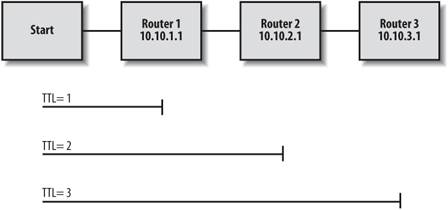trace
trace (also known as "traceroute" on Unix systems or "tracert" on Windows systems) tries to discover the actual path a packet takes to a selected destination. On Unix, it accomplishes this by using the TTL (time to live) field of a UDP packet. On Microsoft platforms, ICMP is used instead of UDP. The TTL is the number of hops a packet is allowed to take before the network gives up the delivery attempt and returns an error message to the sender. Each hop through a router decrements the TTL counter until the TTL hits 0, at which time the router returns the packet to the originator with a "TTL expired" error. Three packets are sent for each TTL because there's no guarantee that all will make the journey.
trace starts by sending a packet to a UDP port on the destination with a TTL of 1. The UDP port is unimportant as long as it's not being used by the destination. Cisco routers pick a default port of 33434. When the packet hits the first router, it is returned. The host from which the packet was returned (the source address of the returned packet) is the first gateway between your router and the destination. TRace then sends out a second packet with a TTL of 2. This packet will make it to the second router along the path to the destination, which then returns it. This router is the second gateway in our trace. This process is repeated until the destination is reached and a "port unreachable" message is returned. Figure 16-2 shows this process.
Figure 16-2. Using TTLs to trace the route to a destination

Here's what the output from a trace command looks like:
Router#trace sphinx Tracing the route to sphinx (10.10.3.1) 1 rtr1 (10.10.1.1) 8msec 8msec 4msec 2 rtr2 (10.10.2.1) 8msec 8msec 4msec 3 sphinx (10.10.3.1) 10msec 10msec 10msec
Getting Started
- Getting Started
- IOS User Modes
- Command-Line Completion
- Get to Know the Question Mark
- Command-Line Editing Keys
- Pausing Output
- show Commands
IOS Images and Configuration Files
- IOS Images and Configuration Files
- IOS Image Filenames
- The New Cisco IOS Packaging Model
- Loading Image Files Through the Network
- Using the IOS Filesystem for Images
- The Routers Configuration
- Loading Configuration Files
Basic Router Configuration
- Basic Router Configuration
- Setting the Router Name
- Setting the System Prompt
- Configuration Comments
- The Enable Password
- Mapping Hostnames to IP Addresses
- Setting the Routers Time
- Enabling SNMP
- Cisco Discovery Protocol
- System Banners
Line Commands
- Line Commands
- The line Command
- The Console Port
- Virtual Terminals (VTYs)
- Asynchronous Ports (TTYs)
- The Auxiliary (AUX) Port
- show line
- Reverse Telnet
- Common Configuration Items
Interface Commands
- Interface Commands
- Naming and Numbering Interfaces
- Basic Interface Configuration Commands
- The Loopback Interface
- The Null Interface
- Ethernet, Fast Ethernet, and Gigabit Ethernet Interfaces
- Token Ring Interfaces
- ISDN Interfaces
- Serial Interfaces
- Asynchronous Interfaces
- Interface show Commands
Networking Technologies
Access Lists
IP Routing Topics
- IP Routing Topics
- Autonomous System (AS) Numbers
- Interior and Exterior Gateway Protocols
- Distance-Vector and Link-State Routing Protocols
- Static Routes
- Split Horizon
- Passive Interfaces
- Fast Switching and Process Switching
Interior Routing Protocols
Border Gateway Protocol
- Border Gateway Protocol
- Introduction to BGP
- A Simple BGP Configuration
- Route Filtering
- An Advanced BGP Configuration
- Neighbor Authentication
- Peer Groups
- Route Reflectors
- BGP Confederacies
- BGP TTL Security
Quality of Service
- Quality of Service
- Marking
- Older Queuing Methods
- Modern IOS QoS Tools
- Congestion Avoidance
- Traffic Policing
- Traffic Shaping
- AutoQoS
- QoS Device Manager
Dial-on-Demand Routing
- Dial-on-Demand Routing
- Configuring a Simple DDR Connection
- Sample Legacy DDR Configurations
- Dialer Interfaces (Dialer Profiles)
- Multilink PPP
- Snapshot DDR
Specialized Networking Topics
- Specialized Networking Topics
- Bridging
- Hot Standby Routing Protocol (HSRP)
- Network Address Translation (NAT)
- Tunnels
- Encrypted Tunnels
- Multicast Routing
- Multiprotocol Label Switching (MPLS)
Switches and VLANs
- Switches and VLANs
- Switch Terminology
- IOS on Switches
- Basic Switch Configuration
- Trunking
- Switch Monitor Port for IDS or Sniffers
- Troubleshooting Switches
Router Security
- Router Security
- Securing Enable Mode Access
- Routine Security Measures
- Restricting Access to Your Router
Troubleshooting and Logging
Quick Reference
Appendix A Network Basics
Index
EAN: 2147483647
Pages: 1031
